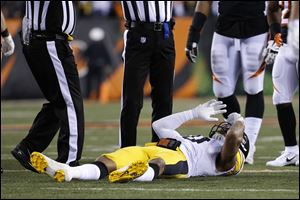
NFL uses its head
8/10/2018
Pittsburgh Steelers linebacker Ryan Shazier suffered a spinal injury last season as a result of a helmet-driven tackle.
Summer is drawing to a close — which means, for many fans, one thing: the start of football season.
Each year, the NFL returns with minor rule-tweaks that have been agreed during the previous season by owners. Many of these changes — for example, about what counts as a catch — go unnoticed by most.
Click here to read more Blade editorials
That isn’t the case this season. In March, the NFL announced a new ‘helmet rule’, prohibiting players from lowering their head and using their helmet to hit an opponent. Those who violate the rule will be subject to a 15-yard penalty and — if the assault is particularly vicious — ejection, a fine, or suspension.
It’s a timely decision: the 2017 season featured an all-time high of 281 (recorded) concussions. Multiple studies have found that even a single concussion can cause serious neurological problems, including an elevated risk of Parkinson’s disease.
Pittsburgh Steelers fans know the damage caused can, in bad cases, be even worse: local linebacker Ryan Shazier was left with a severe spinal injury after attempting one during a game last December. Only in the past two months has he been able to begin walking again without the assistance of a cane.
Despite this, the change has brought the NFL — again — into controversy.
Critics of the rule – including many of the same players it’s meant to protect — argue it changes the character of the sport by eliminating some of the physicality its famous for. Star San Francisco 49ers cornerback Richard Sherman worries the new rule could “ruin the game.” Minnesota Vikings safety Andrew Sendejo was spotted sporting a “Make Football Violent Again” hat during training camp.
The organization should stand by its decision. The ongoing fallout from its concussion crisis — which, in addition to reputational damage, has cost the NFL over a billion dollars in the form of settlements to ex-players — has hurt the league. Measures like the helmet rule will help get the sport back on track.
Perhaps more importantly, it’s also a matter of survival: the concussion controversy is one reason that the number of 6-to-12 year olds playing football fell 30 percent between 2008 and 2016. Parents need clear signals that organizers are serious about promoting player safety.
Much of the drama plaguing the NFL in recent years has been beyond its control. The national anthem debate, for example, is an extension of the country’s culture wars. Any stance the league takes on that issue will always risk alienating half of its audience.
This drama is different. Banning helmet hits is well within the league’s control and, despite the protestations of some fans and players, it will not divide the country. The NFL should stick with the change: the decision is — so to speak — a no-brainer.